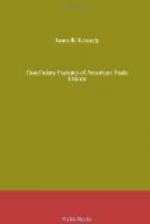[Footnote 143: See page 80.]
[Footnote 144: Exemption of half dues.]
The sick benefit is intended to support members and their families while the member is unable, through illness, to work. Such sickness, to entitle a member to the benefit, must in all the unions be an illness which prevents him from “attending to his usual vocations."[142] Practically all the unions provide, however, that if the sickness is the result of “intemperance, debauchery or other immoral conduct” the benefit shall not be paid. A few of the unions also specifically provide that illness “caused by the member’s own act” shall not constitute a claim for the benefit.[145]
[Footnote 142: Iron Molders’ Constitution, 1902 (Cincinnati, 1902), p. 37; Cigar Makers’ Constitution, 1896, fourteenth edition (Chicago, n.d.), p. 34; Tobacco Workers’ Constitution, 1900, third edition, 1905 (Louisville, n.d.), p. 25; Barbers’ Constitution, 1902, p. 10; Garment Workers’ Constitution, 1902, p. 37; Piano and Organ Workers’ Constitution, 1902 (n.p., 1903), p. 18; Boot and Shoe Workers’ Constitution, 1906, p. 31; Pattern Makers’ Constitution, 1906, p. 48; Leather Workers on Horse Goods’ Constitution, 1905, p. 21.]
[Footnote 145: The Boot and Shoe Workers, who have a large number of female members, provide that “female members shall not be entitled to [sick] benefits while pregnant nor for five weeks after confinement” (Constitution, 1906, sec. 64).]
In nearly all of the unions a member must have been in continuous good standing for six months to be entitled to receive the sick benefit. The Plumbers require that he shall have been a member for a year. Such requirements afford protection to some extent against persons in ill health joining the unions in order to receive the benefit. The unions rely almost entirely upon those provisions to prevent such abuse. In practically none is an examination regularly required in order to determine whether the candidate for admission to the union is likely to be a heavy risk. Certain of them do provide, however, that in case the candidate at the time of his admission is over a fixed age, or in case he is afflicted with a chronic disease, he shall be entitled to a smaller weekly benefit than would otherwise be the case. Thus, in the Typographia members fifty years of age and those passing unsatisfactory medical examinations pay five cents less weekly dues than regular members, but can draw no benefit until after two years’ good standing. At the expiration of this period they may receive three dollars per week, two dollars less than the regular benefit, for fifty weeks, and then one dollar and fifty cents, half of the regular benefit, for another fifty weeks.




